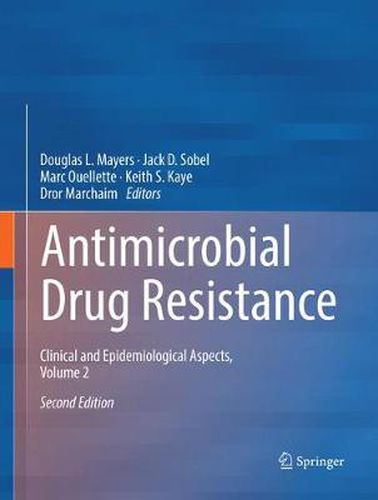Readings Newsletter
Become a Readings Member to make your shopping experience even easier.
Sign in or sign up for free!
You’re not far away from qualifying for FREE standard shipping within Australia
You’ve qualified for FREE standard shipping within Australia
The cart is loading…






This title is printed to order. This book may have been self-published. If so, we cannot guarantee the quality of the content. In the main most books will have gone through the editing process however some may not. We therefore suggest that you be aware of this before ordering this book. If in doubt check either the author or publisher’s details as we are unable to accept any returns unless they are faulty. Please contact us if you have any questions.
The two volumes included in Antimicrobial Drug Resistance, Second Edition is an updated, comprehensive and multidisciplinary reference covering the area of antimicrobial drug resistance in bacteria, fungi, viruses, and parasites from basic science, clinical, and epidemiological perspectives. This newly revised compendium reviews the most current research and development on drug resistance while still providing the information in the accessible format of the first edition. The first volume, Antimicrobial Drug Resistance: Mechanisms of Drug Resistance, is dedicated to the biological basis of drug resistance and effective avenues for drug development. With the emergence of more drug-resistant organisms, the approach to dealing with the drug resistance problem must include the research of different aspects of the mechanisms of bacterial resistance and the dissemination of resistance genes as well as research utilizing new genomic information. These approaches will permit the design of novel strategies to develop new antibiotics and preserve the effectiveness of those currently available. The second volume, Antimicrobial Drug Resistance: Clinical and Epidemiological Aspects, is devoted to the clinical aspects of drug resistance. Although there is evidence that restricted use of a specific antibiotic can be followed by a decrease in drug resistance to that agent, drug resistance control is not easily achieved. Thus, the infectious diseases physician requires input from the clinical microbiologist, antimicrobial stewardship personnel, and infection control specialist to make informed choices for the effective management of various strains of drug-resistant pathogens in individual patients. This 2-volume set is an important reference for students in microbiology, infectious diseases physicians, medical students, basic scientists, drug development researchers, microbiologists, epidemiologists, and public health practitioners.
$9.00 standard shipping within Australia
FREE standard shipping within Australia for orders over $100.00
Express & International shipping calculated at checkout
This title is printed to order. This book may have been self-published. If so, we cannot guarantee the quality of the content. In the main most books will have gone through the editing process however some may not. We therefore suggest that you be aware of this before ordering this book. If in doubt check either the author or publisher’s details as we are unable to accept any returns unless they are faulty. Please contact us if you have any questions.
The two volumes included in Antimicrobial Drug Resistance, Second Edition is an updated, comprehensive and multidisciplinary reference covering the area of antimicrobial drug resistance in bacteria, fungi, viruses, and parasites from basic science, clinical, and epidemiological perspectives. This newly revised compendium reviews the most current research and development on drug resistance while still providing the information in the accessible format of the first edition. The first volume, Antimicrobial Drug Resistance: Mechanisms of Drug Resistance, is dedicated to the biological basis of drug resistance and effective avenues for drug development. With the emergence of more drug-resistant organisms, the approach to dealing with the drug resistance problem must include the research of different aspects of the mechanisms of bacterial resistance and the dissemination of resistance genes as well as research utilizing new genomic information. These approaches will permit the design of novel strategies to develop new antibiotics and preserve the effectiveness of those currently available. The second volume, Antimicrobial Drug Resistance: Clinical and Epidemiological Aspects, is devoted to the clinical aspects of drug resistance. Although there is evidence that restricted use of a specific antibiotic can be followed by a decrease in drug resistance to that agent, drug resistance control is not easily achieved. Thus, the infectious diseases physician requires input from the clinical microbiologist, antimicrobial stewardship personnel, and infection control specialist to make informed choices for the effective management of various strains of drug-resistant pathogens in individual patients. This 2-volume set is an important reference for students in microbiology, infectious diseases physicians, medical students, basic scientists, drug development researchers, microbiologists, epidemiologists, and public health practitioners.